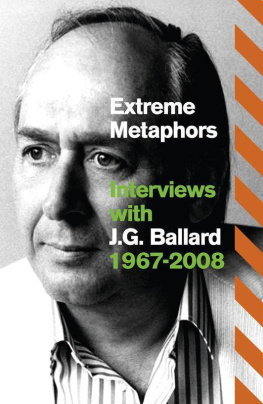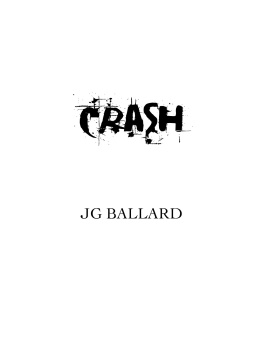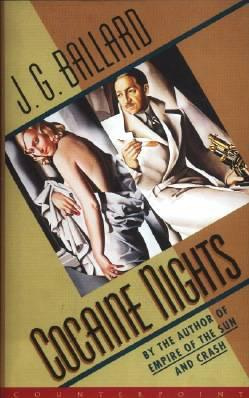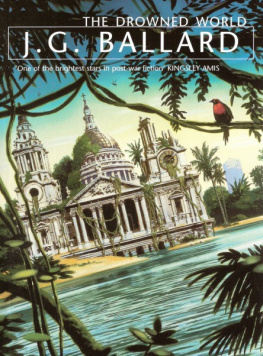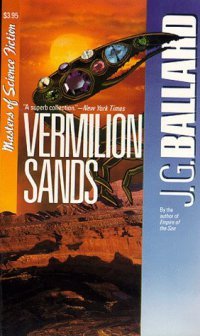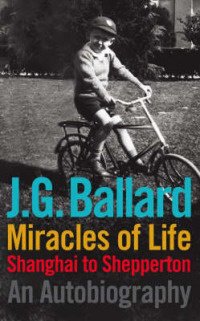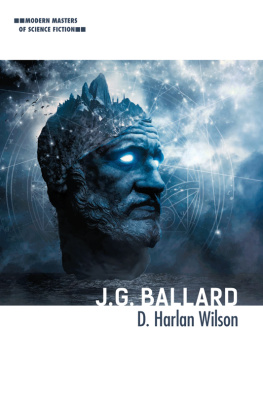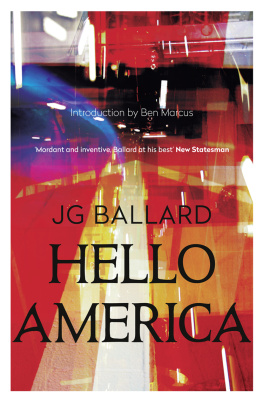Extreme Metaphors
Selected Interviews with J.G. Ballard, 19672008
Edited by Simon Sellars and Dan OHara

Contents
I
The conditions of J.G. Ballards childhood in wartime Shanghai are well known, exposed by the success of his semi-autobiographical novel Empire of the Sun (1984), and Steven Spielbergs film version of that compulsive self-mythology. Yet pre- Empire , Shanghai was admitted only in metaphor to Ballards writing, and the war mentioned en passant in the ubiquitous mini-biographies adorning the front-papers of his novels. A typical example might have read: He was born in Shanghai in 1930 to English parents. The Japanese interned him for almost three years in a civilian war camp. He came to England when he was sixteen. He studied medicine at Kings College, Cambridge. He worked as a copywriter, then as a Covent Garden porter, then as an editor on a scientific journal. He trained to become an RAF pilot. His first professionally published short story was Prima Belladonna in 1956. He was a leading light in the so-called New Wave of science fiction. He lives in Shepperton, England. Crash is his most notorious novel Occasionally, there would be self-reflexive variations, statements so intense they were surely the handiwork not of bored copywriters but of Ballard himself: He believes that science fiction is the authentic literature of the twentieth century (or that science fiction is the apocalyptic language of the twentieth century). He also believes that inner space, not outer, is the real subject of science fiction.
Today, given Ballards post- Empire canonisation, its easy to forget he began as a writer of science fiction, although in the 1960s he established his name with a quartet of end-of-the-world disaster novels that keenly anticipated current conditions surrounding climate change: The Wind from Nowhere (1961), The Drowned World (1962), The Drought (1964) and The Crystal World (1966). In that decade, he also produced a number of short stories that inverted science fiction via one of its most cherished tropes, time travel, using the premise to formulate the fabled theory of inner space informing those early bios. Anticipating Marshall McLuhan and Jean Baudrillard, Ballard demonstrated how encroaching advertising and mass consumer culture played on submerged desire, implanting new, artificial subjectivities to create a schizophrenic underclass. In response to such conditions, his characters retreated into the private imagination inner space cordoning it off as a virtual nature reserve, preserving its sovereignty by any means possible. A recurring theme was the idea of escaping or cheating time, precipitated by a period of psychic turmoil. Recording the Dal-esque motif of stopped or melting time, Ballard uses the symbolism of time (that is, the unit of measurement; clock time) as an arbitrary, man-made construct imposing order and control on the free reign and chaos of the unconcious. Faced with the reality of life in that tumultuous decade, inner space for Ballard was a far more strange and compelling setting for science fiction than its traditional environs in outer space.
Coining the slogan Earth is the only alien planet, Ballard joined forces with Michael Moorcock to lead the British New Wave, producing an extended, linked sequence of fragmentary, non-linear short stories that continued to address the psychosocial effects of the media landscape. These were mainly published in Moorcocks revolutionary New Worlds magazine, the mouthpiece for the New Wave, and later collected as The Atrocity Exhibition (1969), which, billed as an experimental novel, cemented his reputation as a dark magus, a writer able to face the most extreme aspects of our culture and divine a secret logic from the chaos.
In the mid-seventies, Ballard mostly abandoned formal experimentation in favour of a more traditional narrative technique, although the subject matter was just as confrontational, perhaps even more shocking for the neutral style encasing it. The novels of this period include Crash (1973), about a cult of bored, middle-class professionals who feel alive only after modifying their bodies via staged car crashes; Concrete Island (1974), about a man who crashes into a patch of wasteland beneath a motorway, subconsciously marooning himself in the city; and High-Rise (1975), in which a high-tech apartment block descends into tribal warfare. These seductive, disturbing narratives seek out the edgelands of cities, making strange the familiar landscapes of suburbia, and have proved enormously influential for their clinical portrayal of the new roles we assume from the technological landscape. They have inspired not only writers but also musicians, artists and film-makers, who respond to Ballards highly imagistic style (itself influenced by surrealism), and even architects and urbanists, drawn to his penetrating critique of the contemporary urban condition.
Then came a brace of unclassifiable novels: The Unlimited Dream Company (1979), Hello America (1981), The Day of Creation (1987) and Rushing to Paradise (1994). If an overarching theme could be detected, its perhaps that each presented a lysergic vision of mythical lands (sometimes right before our eyes, as in suburbia) undermining and degrading the structural integrity of the urban West. In between were Empire and its sequel The Kindness of Women (1991), both playing surrealistic games with Ballards life story.
In his later career, there was a final incarnation: Ballard, the writer of subversive crime fictions such as Running Wild (1988), Cocaine Nights (1996), Super-Cannes (2000), Millennium People (2003) and Kingdom Come (2006). Indeed, crime was the perfect genre for the age of conspiracy theory and inscrutable global power structures that would come to define the new millennium, and which Ballards work had always foretold. Of course, he continued to write brilliant short stories throughout, as well as the novella Low-Flying Aircraft (1976), about a near future in which humans are dying out, and regarded as among his finest work.
Actually, what this potted history suggests is that Ballards career is almost impossible to summarise. Reading the blurbs of his later novels, therefore, with their Shanghai- Empire focus, feels like submitting to a ritual incantation designed to fix a public mask for this most elusive of writers. In reality, if your first introduction to Ballard is by way of, say, his short story The Drowned Giant (1964), then you might think you have stumbled on to a master magical realist in the Swiftian tradition. If Crash is the initiation, then you might think twice before proceeding further, unless your palate is already sufficiently developed with a taste for the blackest intellectual meat. And what if your introduction is via one of the many interviews he gave across the arc of his career?
Ballard published approximately 1,100,000 words in novels, 500,000 in short stories and at least 300,000 in non-fiction. The combined word count of all the interviews he gave is around 650,000. In the Ballardian galaxy thats a second sun, an enormous parallel body of speculation, philosophy, critical inquiry and imaginative flights of fancy that comments critically on his writing, often explains it and, sometimes, extends or even goes beyond it. Ballard enjoyed talking about his work, in marked contrast to the contemporary literary landscape where authors see interviews as a tiresome duty, or as a PR exercise, a chance to push product, or even as a chance to vent spleen on real and imagined enemies. As Iain Sinclair said of him: He doesnt speak badly of anybody, any named individual. Its almost a superstition, no gossip. In interviews, it was common for him to ignore any mention of literature and fellow writers altogether. Questions as to his literary influences were often deflected or summed up with a short list of his childhood reading.
Next page
